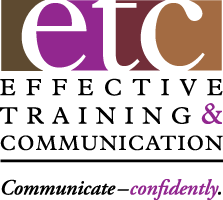(We continue our popular year-long ‘Do Your Presentations Suck? series this month with a deep dive into your presentation’s Main Point. So, buckle up for another fast ride.)
Your Main Point (MP) might suck if you don’t have a clearly defined one – the key message you want the audience to understand, remember and agree with after your presentation. It’s the essence of your message, boiled down to one concise, specific, positive sentence you could write on the back of your business card.
Everything you say will connect directly to your MP. It’s neither the topic of your presentation or its title. For example, my topic could be ‘ETC Sales Pitch’ and the title could be ‘Present with More Power and Success’, but my Main Point should be something like ‘ETC … an excellent resource for enhancing executive presentation skills.’
Your Main Point might really suck if your audience only hears it once. They should hear it at least once in the introduction, three or four times during the body of the presentation and one last time in the summary or conclusion. Studies regularly indicate that the more often people hear something, the greater the chance they’ll remember it. That doesn’t mean they’ll agree with it, just remember it.
Your Main Point might also really suck if you have more than one of them. Ever been in the audience when the speaker says ‘Today, I want to discuss five … seven … ten points’? If so, you probably started dreading the ordeal to come. One of the doctrines of Audience-Centricity is that ‘Less is More’, so one Main Point sounds a whole lot more bearable that a larger number.
Your Main Point will definitely suck if your Sub-Points (SP) don’t all connect to and support it or you have too many of them. These are key messages you must deal with to accomplish the goal of your MP – getting the audience to remember and believe it. And three SPs tend to be a manageable number – we can easily remember and tolerate three. Even if you had 10 separate concepts to share, you can repackage them with a spin so they turn into three.
Another Best Practice is to describe these SPs as questions. So, I could say something like ‘Today, we’ll be briefly discussing ETC… an excellent resource for enhancing executive presentation skills. To do that, let’s answer three important questions on your mind: ‘What is ETC?’, ‘How do we empower executives to take the pain out of workplace presentations?’ and ‘Why should you partner with ETC?’
By phrasing SPs as questions, it implies that you’ve thoroughly analyzed what your audience needs and wants and are prepared to deliver it. It also suggests that the presentation to follow will be more of a discussion, even if you do all the talking. Subtle concepts for sure, but they can have a positive impact on your audience and results.
Now, build out each SP with facts, statistics, comparisons, expert quotes, references, examples or anecdotes. But, only mention what you think or know they need and want to hear to answer each SP question. It’s not at all about what you want to say.
So, the trick to making sure that your Main Point doesn’t suck is to clearly define it in audience-centric terms, repeat it throughout your presentation, connect it to supporting Sub Points and make it memorable.
